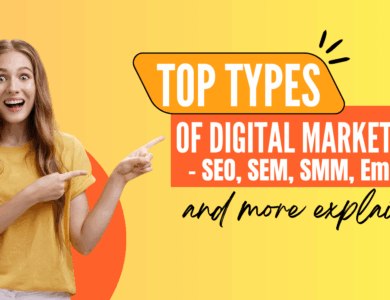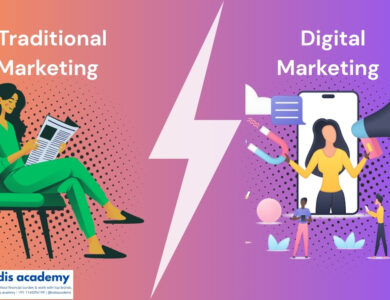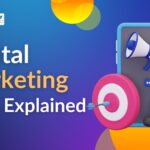What Is Digital Marketing? Definition, Basics & How It Works

Ever wondered how those perfectly timed ads know exactly what you’re looking for? Or why some brands dominate your social media feed while others barely exist?
Welcome to the fascinating world of digital marketing — the heartbeat of modern business growth. Whether you’re a budding entrepreneur, an aspiring marketer, or just curious about how the internet seems to “know” you, understanding digital marketing is no longer optional — it’s essential.
In this blog, we’ll break down what digital marketing really means, explore its core principles, and uncover how it all works behind the scenes.
From search engines and social media to emails and content strategies, you’ll learn how brands reach the right people at the right time. So if you’re ready to dive into the engine that powers the online business world — let’s get started!
What Is Digital Marketing?
Imagine trying to promote your business in a world where most people spend more time online than anywhere else. Sounds like a challenge, right? Well, that’s exactly where digital marketing comes in — it’s the art and science of reaching your audience where they already are: the internet.
Digital marketing refers to all marketing efforts that use the internet or electronic devices to connect with potential customers. Businesses use digital channels like search engines, social media platforms, email, websites, mobile apps, and even SMS to promote their products or services.
Whether it’s a Facebook ad, a Google search result, or an email in your inbox — that’s digital marketing at work.
But digital marketing isn’t just about being online — it’s about being strategically visible. It’s about delivering the right message to the right person at the right time.
Learn AI & Digital Marketing,
Pay Fees After Placement
- ✅ Minimal Admission Fees
- ✅ No Loan or Income Sharing Agreement
- ✅ 100% Placement Support
- ✅ ISO & Govt Registered Certificate
- ✅ Practical 3+1 Months Duration
Get a free counseling call. We’ll guide you through learning, certification, and job placement.
Request a Free Call Back
Takes less than a minute.
Why Is Digital Marketing So Important?
Traditional marketing still exists — think TV ads, billboards, or flyers — but it’s often expensive, harder to measure, and lacks the precision digital tools offer. Digital marketing, on the other hand, gives businesses — big or small — the ability to:
- Reach a global audience
- Target specific demographics or behaviors
- Measure results in real-time
- Scale marketing efforts efficiently
From a small local café targeting customers within 5 km using Instagram, to a multinational company running global email campaigns — digital marketing levels the playing field.
The Core Idea: Attention Is Online
Let’s face it — people are glued to their phones and laptops. Whether they’re scrolling on Instagram, Googling the best sushi near them, watching YouTube videos, or reading product reviews — the average person spends hours a day online.
This behavior shift means businesses no longer need to chase customers with cold calls or door-to-door pitches. Instead, they can attract, engage, and convert users online with content that adds value.
Key Objectives of Digital Marketing
At its heart, digital marketing focuses on three primary goals:
- Attract – Bring potential customers to your website, app, or platform through organic or paid strategies.
- Engage – Keep them interested with useful, relevant content and interactions.
- Convert – Encourage them to take action — whether it’s making a purchase, filling out a form, or subscribing to a newsletter.
It’s Not Just About Selling
One of the biggest misconceptions is that digital marketing is only about sales. While driving revenue is a key objective, digital marketing is also about:
- Brand awareness – Making people know your brand exists.
- Customer relationship building – Engaging users through personalized content.
- Trust and credibility – Creating content that builds authority in your niche.
- Customer retention – Staying connected through follow-ups and loyalty campaigns.
It’s Always Evolving
The digital space never stands still. New platforms emerge, algorithms change, and audience behavior shifts. A strategy that worked wonders a year ago might flop today. This constant evolution makes digital marketing both challenging and exciting. The best marketers are those who adapt, learn, and experiment continuously.
Main Key Channels of Digital Marketing
Now that you know what digital marketing is, let’s talk about where it actually happens — the channels. Think of these channels as the different roads that lead customers to your brand. Each has its own style, strengths, and strategy. Some are organic (free but time-consuming), while others are paid (fast but budget-dependent). Let’s break them down one by one.
1. Search Engine Optimization (SEO)
When someone types a question into Google, how does your website show up on the first page? That’s the magic of SEO. It’s all about optimizing your content and website so that search engines rank you higher for relevant keywords.
With SEO, you’re not paying for ads — you’re earning visibility by creating helpful, valuable content that answers what your audience is searching for. It takes time, but the results are long-lasting and powerful.
Key elements include:
- Keyword research
- On-page SEO (titles, headings, internal links)
- Technical SEO (site speed, mobile-friendliness)
- Off-page SEO (backlinks from other sites)
2. Content Marketing
“Content is king” might sound cliché, but it’s still true. Content marketing is all about creating blogs, videos, infographics, eBooks, and more to educate, inform, or entertain your audience — while gently guiding them toward your product or service.
Good content builds trust, positions your brand as an authority, and plays a huge role in your SEO and social media efforts.
Examples:
- Blogging for SEO traffic
- Educational YouTube videos
- Downloadable guides or case studies
- Email newsletters with valuable insights
3. Social Media Marketing
From Instagram reels to Twitter threads to LinkedIn articles — social media is where the conversations are happening. Whether you’re a B2B company or a small bakery, social media marketing allows you to connect with your audience in real-time and build a community.
Each platform has its own vibe:
- Instagram & Facebook – Visual storytelling, ads, influencer marketing
- LinkedIn – B2B networking, professional content
- Twitter (X) – Real-time updates, trends, witty brand voice
- YouTube – Video tutorials, vlogs, product demos
Consistency is key here — not just in posting, but in engagement and branding.
4. Email Marketing
One of the oldest yet most effective channels, email marketing gives you direct access to your audience’s inbox. It’s personal, cost-effective, and ideal for nurturing leads, sharing updates, and driving repeat sales.
Whether it’s a welcome series, a weekly newsletter, or a product launch announcement, email lets you speak directly to people who’ve already shown interest in your brand.
Pro tip: Personalization and segmentation make a huge difference. No one likes a generic email!
5. Pay-Per-Click Advertising (PPC)
Need quick results? Enter PPC advertising — where you pay each time someone clicks on your ad. These can appear on Google (via Google Ads), social media platforms, or even other websites.
PPC is great for targeted campaigns, promotions, or driving traffic during specific events. But remember — money alone doesn’t guarantee success. A well-crafted message, the right audience, and smart budgeting are musts.
Popular platforms:
- Google Ads (Search & Display)
- Facebook & Instagram Ads
- LinkedIn Ads
- YouTube Ads
6. Affiliate Marketing
In affiliate marketing, other people promote your product for a commission. It’s like having a team of marketers who only get paid when they bring in results. Bloggers, influencers, YouTubers, and even websites can become your affiliates.
If set up right, this channel can scale your revenue while keeping marketing costs performance-based.
7. Influencer Marketing
People trust people. That’s why influencer marketing has exploded — brands partner with individuals who have large or loyal followings to promote their offerings. The key here is authenticity. Micro-influencers (smaller but engaged audiences) often bring better ROI than celebrities.
How Digital Marketing Works
So, we’ve talked about what digital marketing is and the channels it uses — but how does it actually work? What’s happening behind the scenes when you see an ad, open a marketing email, or stumble upon a blog that magically answers your exact question?
Let’s break it down in a way that’s simple, relatable, and clear.
It Starts with Knowing the Audience
Everything in digital marketing begins with one question:
“Who are we trying to reach?”
Before any campaign goes live, marketers dive deep into understanding their target audience — their age, interests, problems, online behavior, and even the time they’re most active online.
The more specific you get with this, the better your chances of connecting. After all, shouting into a crowd doesn’t work — but whispering into the ear of the right person? That’s gold.
Step-by-Step: The Journey of a Digital Marketing Campaign
Here’s a simplified flow of how digital marketing really works:
1. Attract: Bringing People In
This is the first and most crucial stage — getting attention. Brands use tools like SEO, social media posts, paid ads, and content marketing to draw potential customers to their website, landing page, or social profiles.
Imagine someone searching for “best running shoes under ₹3000” on Google. If your blog or product page appears in those results — boom! You’ve attracted a potential buyer without even making a pitch yet.
2. Engage: Keep Them Interested
Now that someone has landed on your page, the next job is to make them stay. That’s where high-quality content, user-friendly design, and clear messaging come into play.
Maybe they’re reading a blog post, watching a video review, or browsing through your products — everything should feel helpful and relevant. Think of this stage like a conversation. The goal is to make the visitor say:
“Hmm… this brand gets me.”
3. Convert: Turning Visitors into Customers
Here’s where the action happens. After building trust and interest, the next step is a conversion — this could mean:
- Filling out a contact form
- Signing up for a newsletter
- Making a purchase
- Booking a free consultation
This step is supported by powerful tools like landing pages, call-to-action buttons (CTAs), and even remarketing ads that remind users to come back and finish what they started.
4. Nurture: Stay Connected
Digital marketing doesn’t end after the first sale or signup. Smart marketers use email marketing, retargeting, and social engagement to stay in touch with their audience and turn one-time buyers into loyal fans.
For example, a follow-up email that says, “Thanks for your purchase! Here’s how to get the most out of it” not only feels personal — it builds long-term trust.
The Role of Data & Analytics
Here’s the best part about digital marketing: everything is measurable.
Unlike traditional marketing where you’d place an ad and just hope for the best, digital marketing lets you track:
- Who clicked your ad
- How long someone stayed on your site
- Which email got more opens
- What content led to actual sales
This data helps you tweak, improve, and grow faster. It’s like having a dashboard for your business that tells you what’s working and what’s not — in real time.
Final Thought: What Is Digital Marketing?
Digital marketing is more than just a trend — it’s the heartbeat of modern business communication. In a world where attention is the new currency, digital marketing helps brands not only get noticed but also build genuine connections with their audience.
From the moment someone searches for a solution to the final click that leads to a purchase (and beyond), digital marketing is working behind the scenes — guiding, nurturing, and converting.
Whether you’re a small business owner, a student, or someone curious about how the online world works, understanding digital marketing gives you a powerful edge.
It teaches you how people behave online, how brands grow, and how technology and creativity can come together to drive real results.
The beauty of digital marketing is its flexibility — there’s no one-size-fits-all approach. You can start small, experiment, learn, and scale. It’s measurable, adaptable, and always evolving.
So if you’re wondering whether it’s worth diving into — the answer is a loud, clear yes. The future of marketing is digital, and the sooner you understand it, the better equipped you’ll be to thrive in today’s competitive, fast-paced world.





